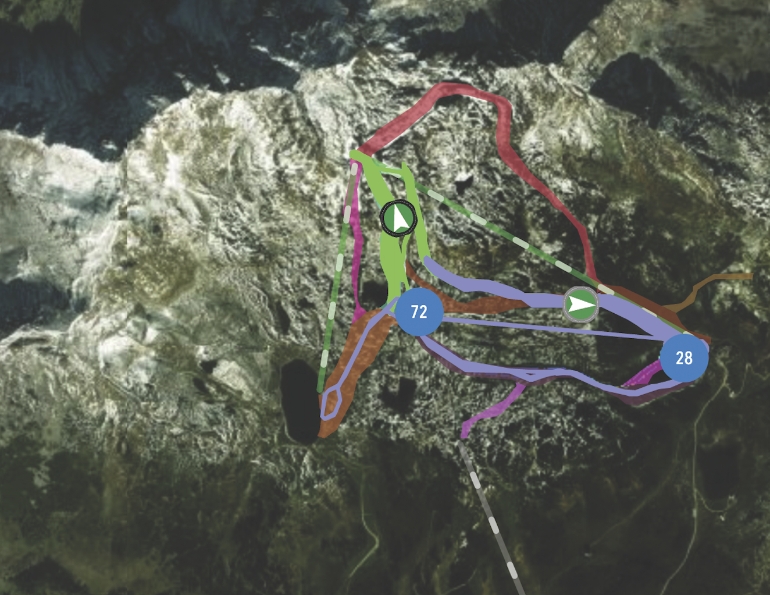Mountain operations teams have traditionally functioned and stayed organized largely by routine, using paper checklists and clipboards, and relying on institutional knowledge. Introducing a new software platform that promises to make their work more efficient and provide management with solid data should be a welcome change—but that doesn’t happen by simply flipping a switch. In reality, migration to a new software platform usually takes at least a few months and requires a team effort.
The end results for guests, employees, and the business are what matter most, and many ski resorts are reporting great success through automation of previously-manual work processes. But how do we re-organize the operation to accommodate new data sources, new workflows, and the changing scope of staff responsibilities? It sounds hefty, but could simply mean re-focusing a few staffers’ daily tasks. One example could be reassigning maintenance team members that no longer need to, say, log shift updates to higher-value activities in line with their skills.
SAM investigated change management processes by asking a range of mountain operations teams and technology partners about the implementation/migration of mountain ops management software and what they’ve learned. What follows is not a software functionality shootout; on the contrary, this is a case of diverse suppliers with different value propositions, and this is a discussion about managing for results and leaning into positive changes.
UNIQUE NEEDS AND CONSIDERATIONS
Bob Ackland of STEEP Management has been working to apply best practices from other industries to the ski industry throughout his career. The former president of Sugarbush, Vt., taps his experience from the world of marine recreation and his tenure at IBM to identify solutions to common obstacles in areas such as the implementation of digital tools.
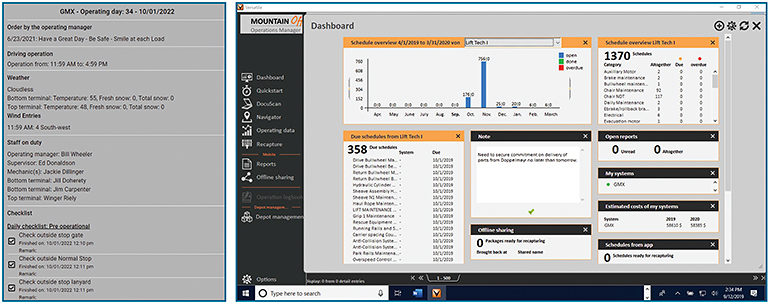 STEEP Management’s MountainOffice helps to organize and manage tasks digitally, such as lift operations daily operating log (below) and schedule overviews (dashboard, right).
STEEP Management’s MountainOffice helps to organize and manage tasks digitally, such as lift operations daily operating log (below) and schedule overviews (dashboard, right).
“Ski resorts struggle to define meaningful benchmarks to analyze the benefit of automation,” he says. “The other problem is data integrity disparity—the operation will be dealing with automated data on one hand, and less-reliable manual-entry data for another system, which makes it hard for senior leaders to draw the right conclusions.”
Data disparity gets to the crux of why some operations management solution modules gain buy-in quickly, like fleet maintenance; and others, like task managers, might take more effort to successfully adopt.
“The challenge is that many operators aren’t in a position to put in the effort of analysis to fully define what functions are most crucial, and what metrics will be used to monitor progress,” says Prinoth’s Mike Robert. Prinoth, known for its grooming machines, has expanded its domain into SaaS offerings for mountain ops teams, namely Prinoth Connect.
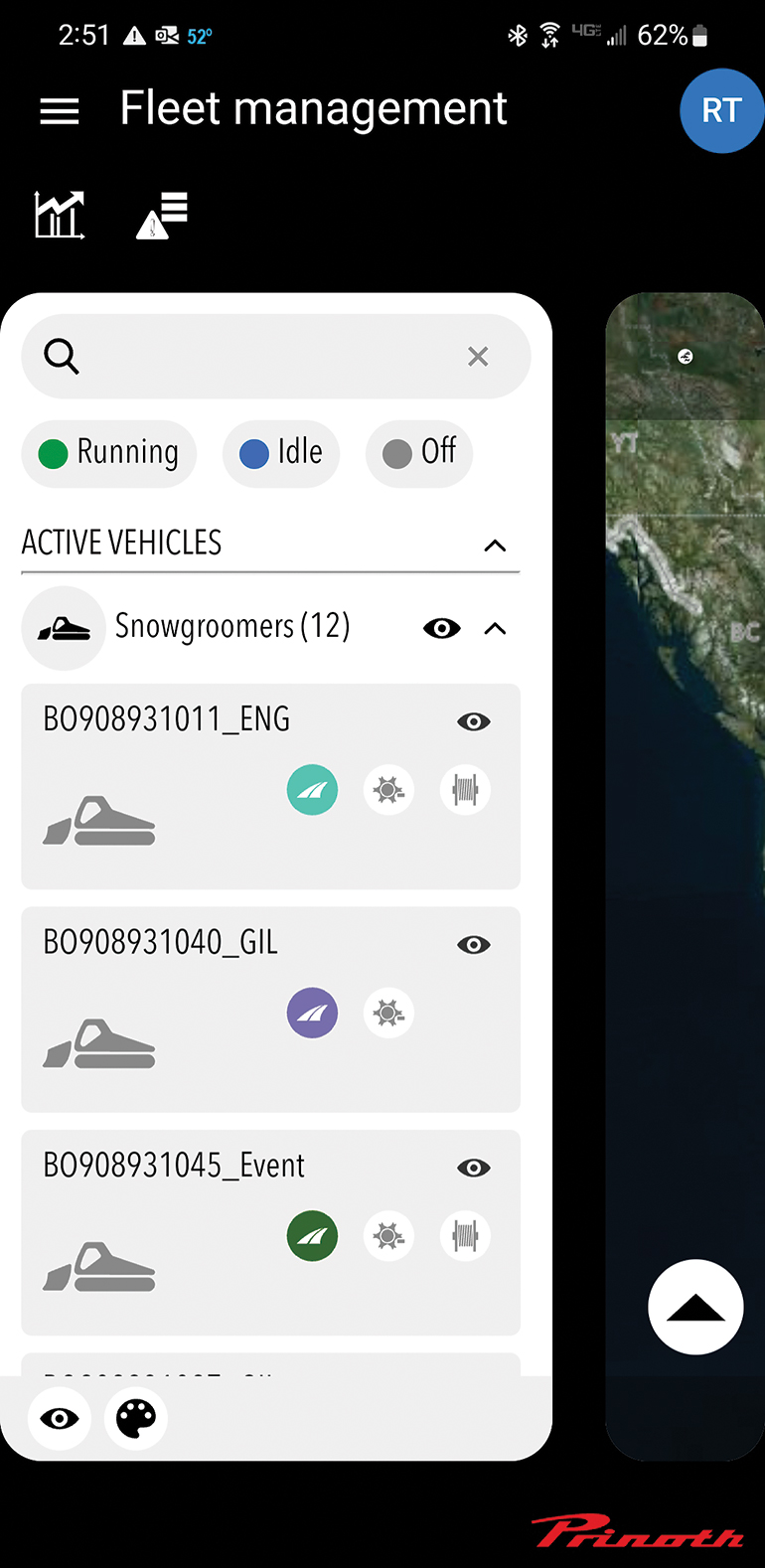 Prinoth has expanded into SaaS offerings with Prinoth Connect (mobile view, below).
Prinoth has expanded into SaaS offerings with Prinoth Connect (mobile view, below).
When enterprise planning for an ops software implementation, it’s important to make some choices about what KPIs (key performance indicators) matter for which functions (snowmaking, grooming, vehicle maintenance, etc.) and stay committed to them.
Defining objectives. Busy-ness is a barrier for all of us these days, and switching to a new software system designed to help manage mountain ops means you’ve got to define what you want to achieve, and work closely with your technology vendor to make sure those objectives are met.
For example, you want to make logging vehicle data for snowcat operators more efficient and ensure the data is accurate. With the right software tool, this entire task might be eliminated from the cat operator’s remit. In addition, automating the vehicle data would mean significantly cutting back on human error from manual inputs.
Robert offers the example of the cost/benefit analysis of moving versus making snow. If there is a high accumulation of snow in one zone of the resort, is it more efficient to move that extra snow to where it is needed, or make snow in that need area? All of the components exist to run this calculation in real-time, so managers can make the best choices.
Since not every function is easily (or reliably) quantifiable in a clear numerical KPI, it is also possible to choose qualitative, outcome-oriented goals as well.
For example, a resort with a large landmass to manage used Esri—which offers ArcGIS software that uses geo-spatial mapping to provide a cloud-based “digital twin” model of actual mountain terrain—to build a series of map layers identifying land attributes, so the whole team could easily locate restrictions on the land such as fire corridors and environmental protection zones. In this case, it’s not necessarily appropriate to ascribe real-time savings to investing in such an upgrade, but using the model will greatly reduce the risk of costly errors like digging or building in the wrong space.
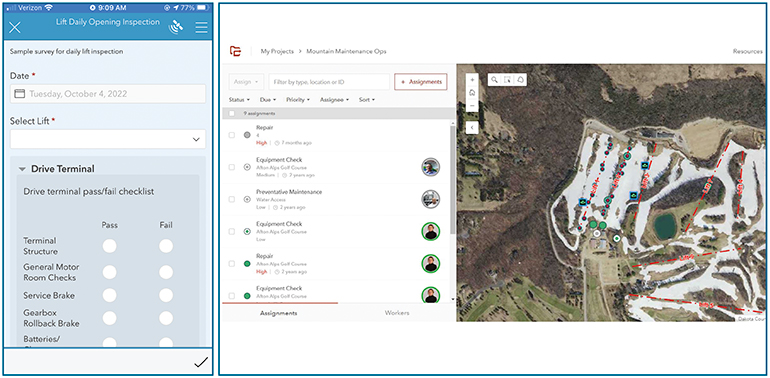 Digitizing manual processes, like a daily lift opening inspection checklist (above, from Esri), is more efficient and gathers accurate data. At right, an Esri dashboard with assignments tracks who is doing what, and where.
Digitizing manual processes, like a daily lift opening inspection checklist (above, from Esri), is more efficient and gathers accurate data. At right, an Esri dashboard with assignments tracks who is doing what, and where.
Systems integration. Many of the mountain ops software interfaces are most powerful when integrated with other data sources—from snow depth to weather to resource consumption.
“Integration is key—many mission-critical systems aren’t designed to ‘talk’ to one another,” says Esri’s Richard Higgins. “Esri users at ski resorts have succeeded in using the system as a hub for integration with other tools and systems. For example, teams within mountain operations are able to integrate hardware such as GPS radios and other telemetry devices into real-time location servicing, allowing dispatch to make better choices regarding on-mountain staff and situations.”
Like Esri’s software, Skadii—a digital resort management solution from Prinoth parent company HTI Group—is an open platform that integrates with other software and hardware. Says Skadii’s Clemens Lantschner: “Analysis of data is crucial in today’s environment from an economical as well as ecological standpoint. We believe in a sustainable ski resort, and data integration to enhance the use of this data is crucial for our path with the ski resorts.”
Overcoming objections. Lastly, when it comes to implementing new processes, know that staff objections are inevitable, so be prepared. When implementing new software, think about the talking points you would want to hear from leadership about using staff time more wisely, eliminating repetitive tasks through automation, and increasing visibility through better data. Whatever the talking points are, keep staff focused on the end business goal.
WHAT’S IMPORTANT IN IMPLEMENTATION?
When it comes to implemnting new software, “Staff isn’t necessarily equipped to make tech or automation decisions,” says Jay Rydd, mountain operations manager at Diamond Peak in California. He describes something of a Gordian knot facing hiring managers: There’s a scarcity of skills (like complex project management or scope definitions) in the talent pool available to most resorts.
Staffing a tech implementation. So, does it make sense to hire a skilled project manager and/or technical resource to oversee the milestones, escalation points, scope and design, and execution of the project tasks? If not, is it worth paying billable hours to the technology provider for implementation support?
The answer is yes, in most cases. Investing in the right solution for your operation is one good step. But implementing and running it properly—and maximizing the value of it—is a different step in the process. If your team doesn’t have the right project resources to define and manage the scope of the process, the project is likely to fail. Staffing a major technology implementation, system migration, or complex integration initiative means that a billable consultant or full-time mountain employee with both hands on the project is not a luxury, it is a prerequisite.
Staffing for a more efficient workflow. While staffing for an integration might be on a temporary basis, there is also the question of how to staff for, and with, a new, presumably more efficient workflow post-migration. That takes us to onboarding and training employees—and providers are prepared to help.
For example, Skadii, says Lantschner, has a digital training tool designed to reduce onboarding times. “Especially for ropeway operations, this gives the ski resort’s owner an advantage to train its employees offline before going to the equipment to save time and make the onboarding more secure,” he says.
Being efficient on the job goes beyond training and onboarding, too. “Taking the time to train staff on new tools can be tough—but we’ve heard back from our customers that the [user interface] available to snowcat operators with SNOWsat is very intuitive and gives more real-time info to the driver, making onboarding new staff much faster,” says JP Wirtz of PistenBully, which offers the SNOWsat platform that includes software modules designed to manage tasks, fleet, snow depth, and maintenance, among others.
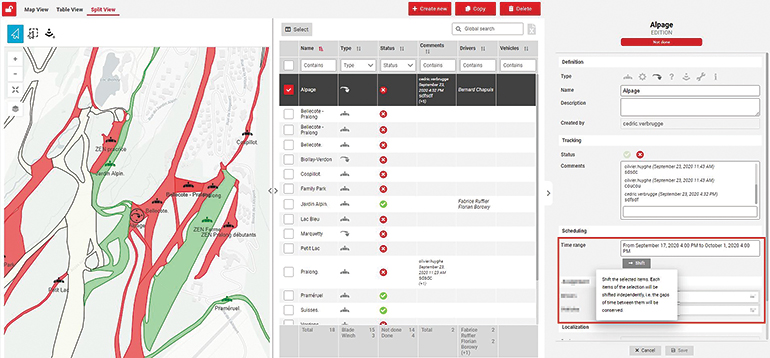 With a task management system, like PistenBully’s SNOWsat ToDo (dashboard, at left), the key outcome should be staff productivity.
With a task management system, like PistenBully’s SNOWsat ToDo (dashboard, at left), the key outcome should be staff productivity.
When it comes to efficiency, the current state of software deployment is a big advantage for the ski industry, as opposed to many others with more onerous IT legacies. In the past, organizations were required to host a server (typically in a remodeled broom closet) and update programs on each PC. Today’s cloud-based technology has the advantage of lightweight maintenance and browser-credentialed interface, which relieves a lot of headaches from higher onsite equipment and staffing costs in the previous era.
SUCCESS FACTORS
The single biggest factor in succeeding with adopting new mountain operations technology is to define what we call a “success.” Apologies to all the devoted project managers out there, but we’ve all seen some projects come and go in our business lives where instead of a well-governed project closure, everyone decided it was over and walked away. But success is not the advanced features of a system, it’s measured in end results.
So, find those areas where your team is already successful, and build upon that to create the pattern of success. Understand what a milestone completion looks like in collaboration with your supplier and commit to progress tracking.
For example, if the objective is to employ a task management system—a function offered by the likes of Skadii, Prinoth Connect, STEEP Management’s MountainOffice, and PistenBully’s SNOWsat ToDo—the key outcome is going to be staff productivity. So, in order to measure this effectively, a set of criteria for different user groups must be established, such as incidents handled by patrol per shift, distance traveled per shift, and then total number of employees required per shift at the end result.
Whether you’re investing in satellite mapping, snow depth, fleet maintenance, or task management tools, set clear goals about what functions are most important and how they need to work in the day-to-day environment.
Also, spend a good deal of time on analysis and definitions for things like job responsibilities, because an outside vendor can’t necessarily do this for you. Luckily, the vendors I spoke to are not only equipped and knowledgeable, they are very eager to see mountain operators deliver the benefits of their technology in their everyday lives.
Once you’ve decided to commit to a new mountain ops management system, or even to seriously evaluate such an investment, build consensus about the desired outcomes that should follow such a change.
The Goals: In goal setting, ensure your team is involved in understanding the business objective. The goal is not “install new technology,” the goal is something akin to:
• Reduce record-keeping errors to below 1 percent.
• Decrease lift loading incidents by 8 percent.
• Reduce utilities costs by 5 percent.
• Increase snowmaking staff retention and satisfaction year-over-year.
The Plan: “If you fail to plan, you plan to fail.” It’s OK not to have a project Dream Team with a roster of skilled resources assigned to it (because that never happens), but it’s not OK to have zero people devoted to a technology project where staff workflows will be impacted.
Whether you’re using MS Project or a whiteboard, a formal plan needs to be composed showing all the key dates, dependencies, milestones, status checks, etc., and should be circulated among key stakeholders so no one feels left out. It’s not good when the sentiment around the shop sounds like, “the IT people are up to something again…” instead of “I’m eager for that new tool to be rolled out so I don’t have to keep wasting time doing this boring repetitive task every shift.”
The Execution: Nothing is certain except for the fact that something will go wrong at some point. That’s what project plans are for.
Suggest to your technology provider that a senior leader on their side should join certain key project calls, along with the mountain operations leadership, to jointly decide on alternatives if necessary, or to even change the direction of the project if priorities shift. This should not be an administrative burden, but it’s always helpful when the leaders are aligned and objectives are clear for everyone involved.
RECAP
Every technology supplier I spoke to has one thing in common—they want their customers to be a true success. Those customers—resort operators—want cash savings, process improvements, happier employees, and guests who can’t wait to come back. And the solutions targeted toward the many functions on a ski hill are getting better and better with each version. It is a good idea to double down during implementations, get into the details, and make sure to get the most value for the investment.
Don’t waste an opportunity to make important changes to your operational processes just by trying to “survive” the implementation. Encourage your teams to lean in, ask smart questions, and investigate ways to make the business work better. It’s an all-too-rare opportunity.
And, of course, change is hard—but it makes us better. Process improvements require thought and refinement, and sometimes space to correct errors. Don’t expect such a thing to be seamless. If the migration was totally seamless, then it begs the question: Was it pointless?





